Italy
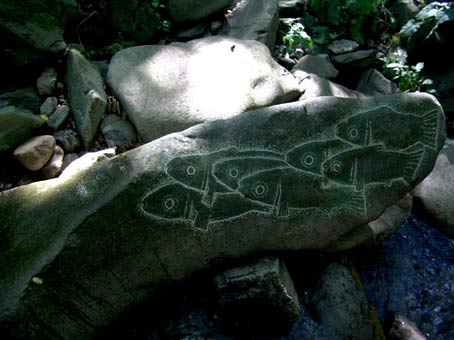
France
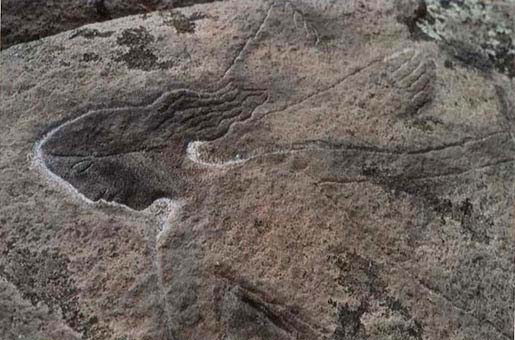
USA
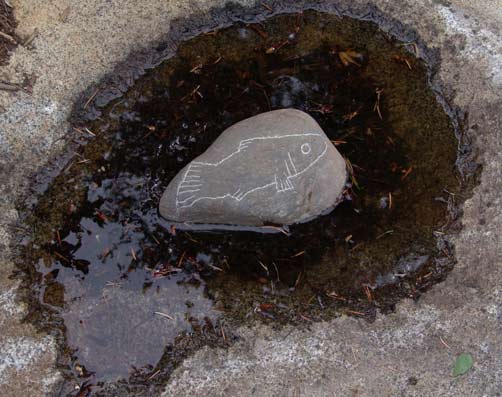
Germany
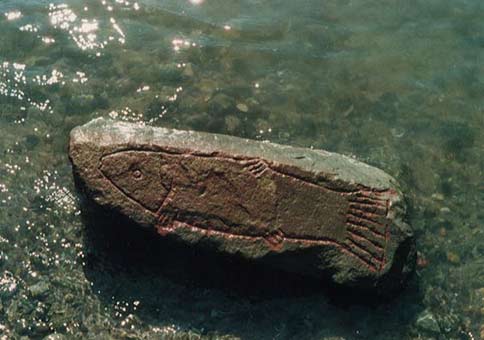
Spain
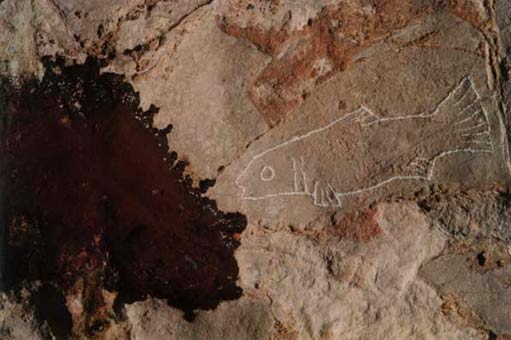
Iran
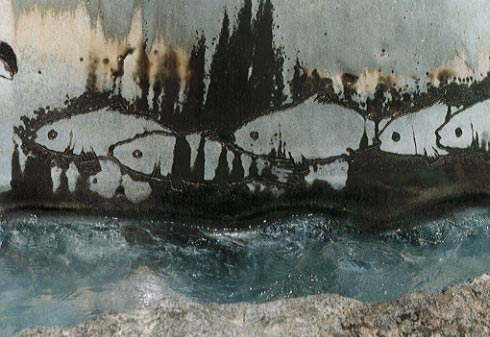
Works by Nadalian in Bangladesh
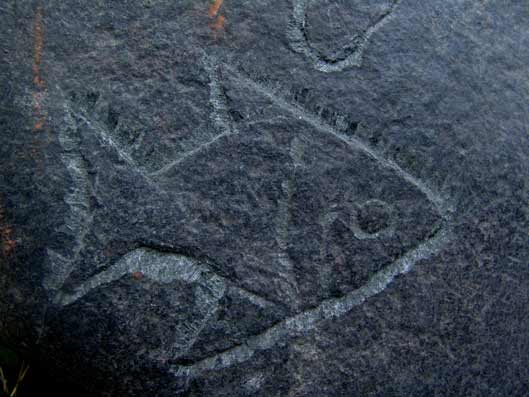
Works by Nadalian in Uzbekistan
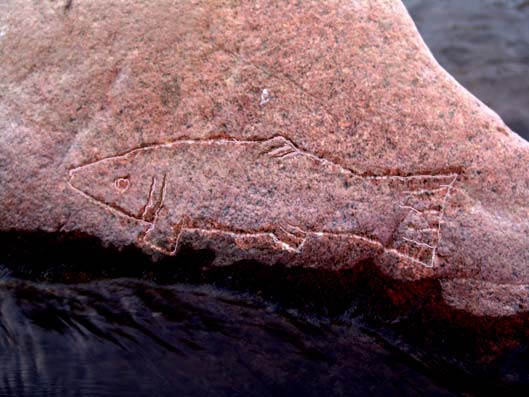
Most of the works of
Ahmad Nadalian in the past decade focused on environmental art.
The works, which
he has named “River Art”, is composed of carved rocks that have been
abandoned at the site where they were created. Various symbols are
incised on boulders- chiefly fish, which for the artist are emblems of
the human soul, thirsty to experience life, but also human figures,
emblems of hands and feet, and images of birds, goats, snakes and crabs.
He leaped to fame
in the West, after representing his River Art project in the 50th
Biennale of Venice. Then he was invited to many countries by
different art centers and organizations for promoting his message.
Now most of
Nadalian works are scattered across the earth. His environmental
art project, include the carving on rocks, can be found in many
countries such as Italy, Germany, USA, Spain, France, Uzbekistan,
Bangladesh, Lebanon, …. and his homeland Iran.
In recent years,
his small carved stones tossed into rivers or buried under the
earth by himself or occasionally by travelers who bury them in
different countries. This project named "Hidden Treasure, An art
exhibition for next millenniums". Over the past decade the artist
has frequently traveled to cities and remote regions and locations
in every continent to work with children and local residents to
create countless treasures. A number of small carved stones
by Nadalian have been buried in different countries such as:
Australia, Burkina Faso, Chad, Egypt, Netherlands, Switzerland,
Russia, Japan, India, Brazil, China, Greece, UK, Finland,
Morocco, South Korea, Ireland, Brazil, Uzbekistan,
France, USA, ... Like archaeological artifacts, most of these
stones are likely to remain hidden for generations.
|
This Map shows the locations of Nadalian's Works
around the glob. The green points show the place where he carved
on the rocks and red points show the countries in which his carvings
were buried. people and different
travelers carried out and buried his carvings in the earth. This project
named "Hidden
Treasures" |
The fundamental
concern of this artist is the search for harmony with nature, with
ourselves, and the universe which surrounds us
(Eva Shakouri
Torreadrado).
His carved stones
and the documentations of his "RiverArt" and "Hidden Treasure"
projects
including, video installation and multimedia
and web art
have been exhibited in 16 individual exhibitions and he has
participated in more than 100 group exhibitions in many countries,
such as Japan, The United Kingdom, Finland, and France, ...
Nadalian's life
and artistic activities in Iran and abroad have been the subjects
of some documentary film by filmmaker such as Mojtaba Mirtahmasb,
Fergus Meiklejohn,
Catherine MacDonald and Vesta Much.
In addition in many TV
reports and interviews focused on Nadalian's environmental works.
Nadalian's life and
artistic activities in Iran and abroad have been the subjects of a
documentary films by Mojtaba Mirtahmasb. His
environmental works have also been recorded by
Fergus Meiklejohn,
Catherine MacDonald and Vesta Mauch.
In addition in many TV
reports and interviews focused on Nadalian's environmental works.
He has been introduced
as one of the world's leading environmental artists by Edward Lucie Smith in his
recent book
Art Tomorrow.
He was photographed by German artist Gottfried Junker who
collected the photos of "The most exciting
Contemporary Artists (a work of 7 years and much travels in the world).
Nadalian enjoys collecting
stones, which he considers to be ready made sculptures. He feels a great bond with nature, and
enjoys living outdoors. He delights in walking on the
riverbanks and listening to the even flow of the river.
Certain questions have always occupied his mind; how does the
inherent harmony of nature give form to these stones through the
flow of water? Can one be as delicate and flowing as water, and
bring order and significance to solid rock? The stones speak
to him. Their shapes exemplify the harmonious structures of the
universe. His most glorious moments are when a chunk of rock captivates
his imagination. His figures already exist in nature. It is not his mind
alone that selects the forms from nature. Perhaps these forms, products
of nature’s harmonious structure, have selected him, and wish to teach
him how to see. He accepts the natural structure, and abides by its
rules. His works depict the balance and flow of nature.
Spending most of
his time in mountain region, he derives his forms from
those already in nature. The shape of a stone is meaningful to him. He
has collected thousands of stones, and each is a distinct figure to him.
In gathering stones and arranging them in novel patterns, he strives to
discover the meanings hidden within.
One of his famous
collection of work is a set of carvings at the Haraz River near Mt.
Damavand (near the village of Poloor, 65 kilometers from the Tehran-Amol
road). This series, which he has named “River Art”, is composed of
carved rocks that have been abandoned at the site where they were
created. He intends to transform this area into a permanent repository
for his art. Instead of being displayed in a gallery or museum, the
artwork has been presented in nature itself.
The designs on the
riverbank are human figures, hands, feet, birds, goats, crabs, snakes
and fish. Symbols of the Zodiac, the sun and the moon surround these
designs, reminding the viewer that the images are not merely
representations of nature, but symbolic concepts. A few examples of
these carved images depict a man and a woman, hands raised upwards to
cup a hollow in the rock, where water gathers during the rain for small
birds to drink. These works recall Anahita, the goddess of water and
fertility. There is a great slab of rock in the middle of this river,
where another of these holes allows water to gather. A bird has been
carved on this rock, its beak lowered into the hollow, appearing to
drink from the water gathered there. Other birds have been carved near
other pools of water along the riverbank.
A number of the
works on the riverbank are images of hands. Eyes look out from the palms
of these hands, and they are surrounded by symbols of water, fire and
earth. The hands reach toward a plant growing near the top, away from
the snake carved at the foot of the stone. This composition could
symbolize a turning from evil, a yearning for growth, fertility and
life, and perhaps the story of Adam and Eve in the Garden of Eden. The
significance of these works lies in their use of natural elements like
water and plants.
He abandons small
carved stones on the riverbank. He leaves his contact numbers and
website address (www.riverart.net) on these stones, yet has no
inclination to disclose their exact whereabouts. What he intends is for
the spectator searching for the artwork to perhaps discover something
more valuable than his stones in nature. He then considers himself a
partner in the spectator’s findings.
But not all of the
work is in a small scale. One of his largest works, a rock about three
meters long, shows a human figure, respectfully seated before a tree;
perhaps the tree of life, or the tree of existence. He has carved
various images on the stones lining the ground among the riverbank and
houses, near bridges and on garden walls—a young piper, a woman’s face
combined with an image of the moon, prints of human feet, birds and
snakes, as well as many other abstract motifs. Set along the banks of
the Haraz are a number of nets filled with stones, set by the villagers
to provide barriers against flooding. Birds have been carved on the
stones in these nets, birds that seem to be trapped in their net cages.
Most of the river
carvings are fish, scattered across a distance kilometers long. In his
childhood, the rivers of Poloor were filled with fish. With the gradual
polluting of the waters the fish disappeared. Through his carvings, he
wishes to tell us that the river still has fish, though only images
remain. The fish is a symbol of life and fertility. Some of the fish are
immersed in water, but a greater number are upon the stones that lie in
the middle of the river, their bodies only partly under water. The rush
of water constantly soaks them, while the bubbling of the river provides
a suitable background for viewing the artwork. In spring, the fish are
often completely submerged in water, while in summer and autumn they are
often entirely dry. This effect is perhaps symbolic of global warming,
drought and threats to survival. Yet to him, the fish symbolizes the
human soul— thirsty to experience life. One of his works at the First
New Art Exhibition at the Tehran Museum of Contemporary Art was a video
of his carvings on the riverbank, emphasizing the role of fish.
Through ritual
ceremony and performances, he hopes to sanctify nature. To
him, walking along a riverbank and washing the stones, which he has
already carved, is not only a performance, but also a prayer, a form of
worship, an invocation. Perhaps even purification, the baptism of a
culture from which only a fossilized image remains. One version of these
performances, usually perform with his family (including his son, his
wife and his mother) is a dedication to rain, blessings and fertility.
Elements such as water, earth, fire and air are used in this work.
He often leaves traces of his wet hand on the
dry rocks of a riverbank, or wet footprints on dry rocks. The imprints
inevitably disappear after a few minutes. To him these finite and dying
traces of hand or feet symbolize the material aspect of man, his
mortality. These dying works by Nadalian, lasting no more than a few
minutes, may appear a wholly different issue from the themes of
fertility, creation and eternity which are depicted on stone forever.
However, the link between them is that the basis upon which both have
been created is water, and they are presented in the river.
His family, ordinary people
and children are not only the audience of his performance, but also
participants. For his body art, he invites an old man to join him. Their
dialogue is very interesting. On the one hand, he performs contemporary
art among the public, ordinary people, trying to make them simple and
understandable. On the other hand, the beliefs of these very people
enrich his works, and the culture which exist among his simple
countrymen is the source of the works he displays and exhibits for
intellectuals.
He greatly enjoys working
with children. The village
children draw charcoal pictures on the rocks of the riverbank, and
he uses these images to carve into the rocks. He uses the vision and
abilities of children to pass his message on to next generation: a
message of love, the love of nature.

Click here for Contact
|